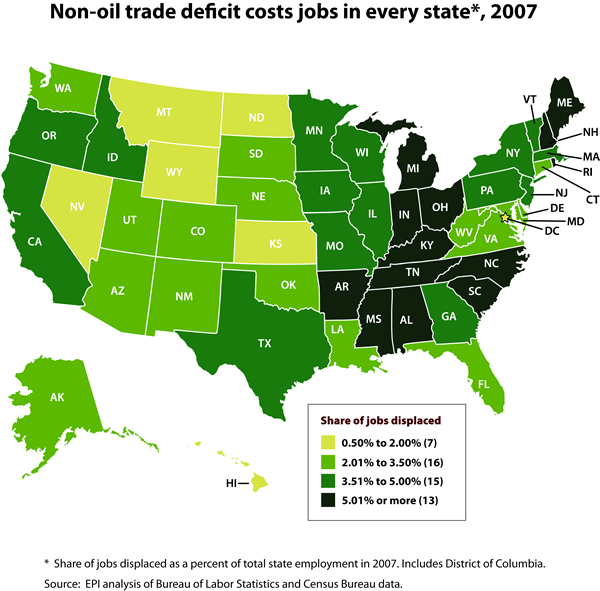See Snapshots archive.
Snapshot for October 2, 2008.
Non-oil trade deficit costs jobs in every state
By Robert E. Scott with research assistance by Emily Garr
In 2007, 5.6 million jobs were lost or displaced by the U.S. non-oil trade deficit (Scott 2008). Despite strong export growth over the past few years, that deficit still totaled $473 billion in 2007, only $48 billion less than its record peak in 2006. More than 4 million (70%) of the jobs displaced by this trade in 2007 were in the manufacturing sector.
U.S. non-oil trade deficits represent reduced domestic demand for goods produced in every region of the United States and have displaced jobs in all 50 states and the District of Columbia (see Map). More than 400,000 jobs or job opportunities were lost in each of California and Texas, and more than 300,000 each in New York, Michigan, and Ohio. Jobs displaced by this deficit exceeded 5.0% of total employment in 2007 in Michigan, South Carolina, Alabama, Tennessee, Ohio, Maine, Indiana, North Carolina, New Hampshire, Kentucky, Arkansas, Rhode Island, and Mississippi. While traditional manufacturing states such as Michigan, Ohio, and the Carolinas were certainly hard hit, so too were states in the tech sector such California, Texas, Oregon, and Minnesota. Many states in the South, such as Kentucky, Tennessee, Arkansas, and Mississippi were hard hit by the loss of textile and apparel industries. Michigan, hard hit by the loss of jobs in the auto industry, lost more than 300,000 jobs or job opportunities overall and was the hardest hit state in the country as a share of total state employment (7.5%).
Printable version of this map [PDF]
Currency manipulation and other unfair trade policies are important causes of U.S. non-oil trade deficits. Elimination of these practices could support widespread growth of U.S. exports and the creation of millions of jobs in export industries such as aerospace products, fabricated metal products, motor vehicles and parts, and chemicals.
For a more detailed look at the U.S. non-oil trade deficit, read the full report.
A weekly presentation of downloadable charts and short analyses designed to graphically illustrate important economic issues, Snapshots are updated every Wednesday.

